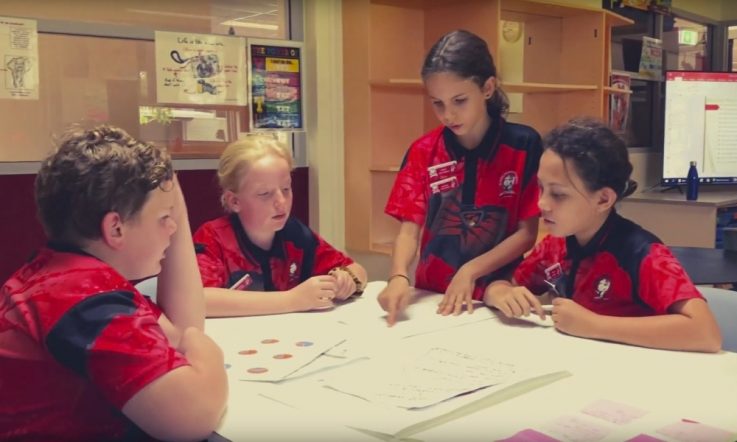The changing attitudes and views of young people – as well as changes to schools' views about young people – over several decades have led to the development and refinement of the term ‘student voice'.
In schools today, student voice is much more than token consultation with students over things like school uniform, or the theme of the school fete. Students want to understand why things are done as they are, and to be able to voice their views about change and to have those views heard (Mahar et al, 2007). They want to be part of those decisions.
This emerging definition of ‘student voice' involves young people in a true partnership with adults, so they can influence what happens to them in school, and become meaningfully involved in their own learning.
Roger Holdsworth is an Honorary Associate of the Youth Research Centre at The University of Melbourne and has a long practical experience on the topic of student voice, agency and participation. Since 1979 he's been publishing Connect, an independent bi-monthly publication documenting and supporting active student participation in primary and secondary schools.
Teacher sat down with him to explore how the definition of student voice has evolved since it first emerged in Australian schools in the 1980s. He also shares why he believes we need to be more precise with the language we use to describe student voice, student agency and student participation.
When student voice emerged in Australian schools
From 1983-85 the Victorian Ministry of Education published a series of policy papers that demonstrated changing views and attitudes towards young people. The sixth policy paper (Ministerial Paper No. 6) in 1984 used terminology that reflected the values and beliefs at the time about the place of students within schools.
‘Terms such as “student empowerment”, “student rights” and “student participation” acknowledged the rights of children and aimed to empower them through various school programs and activities that were regarded as appropriate,' the report says.
The paper stated that schools should ‘ensure that students are clear about what they are expected to accomplish and provide them with increasing opportunities to help determine the educational tasks and goals that are set for them' (Ministry of Education, 1984).
Holdsworth says the terms ‘youth participation in education' and ‘student participation' were first used in Australian schools in the 1970s and 1980s. ‘In the mid-80s, for example, The Age newspaper ran an editorial commenting favourably on the report of the Ministerial Working Party on Student Participation, which said, “encourage students to have their say”. So that idea of voice and speaking up was being talked about then; even though the term “student voice” was not being explicitly used, the concept was still there.'
He says the term ‘student voice' started to emerge more explicitly in the late 1990s. This was an international movement with, for example, a large research project at Cambridge University in the UK, focused around ‘pupil voice' or ‘Consulting Pupils about Teaching and Learning'. Locally, in 1998 Holdsworth presented a paper at two conferences (in Melbourne and in Bangkok) in which he argued the need to move from ‘having a voice' to ‘ideas of “agency” or “action”'.
In this, he presented a continuum of possibilities that ranged from ‘youth/student voice' to ‘sharing decisions' (Holdsworth, 1998; Holdsworth, 2000). This paper also raised questions about ‘whose voice?' and suggested approaches that overcame the differential exclusion of the voices and action of some students.
Along those lines, in 1999, the Victorian Departments of Education and Justice set up a Student Action Teams program. The program was designed to provide opportunities for students to meaningfully participate in making decisions and contributing to their communities – initially around authentic issues of safety.
As part of a Student Action Team, a group of students work together to identify and tackle a school or community issue: they research the issue, make plans and proposals about it, and take action on it. These Student Action Teams are based on the concepts that:
- students can make serious and important decisions;
- students can do important and valuable things;
- students have skills, expertise and a knowledge of the needs of their community;
- important action can be taken as part of students' learning in school; and
- community focused research and action is an appropriate educational approach for schools.
An evaluation of the program identified gains in the personal development of students including enhanced self-esteem, school commitment and communication and teamwork skills (Holdsworth, 2000; Holdsworth, Stafford, Stokes & Tyler, 2001). These Student Action Teams also enabled the participation of students who would perhaps not have been chosen as part of a ‘leadership' group.
In schools today, there is a strong emphasis on embedding student voice and agency into programs and activities. The Victorian Department of Education specifically outlines this in many of its policy and practice documents, including the recent Amplify toolkit.
Being precise in the use of terms
Holdsworth says that, despite its popular use in Australian schools, student voice has now become a ‘stretchable' term that can be used to mean several things. He says ‘student voice', ‘student agency' and ‘student participation' are often used interchangeably, and he believes there is value in being more precise about how we use each of them.
‘That's why I recently became more interested in unpacking these ideas a little more; I don't think it's helpful to have all of these collapsed into the one term.'
Holdsworth says he was hearing lots of discourse around ‘does student voice work?', ‘what is the evidence?' and thought it was impossible to answer these questions without a clear definition of the terms themselves. ‘I kept thinking that it's very hard to pin down the evidence unless we know what it is that we are talking about.
‘If we're talking about a whole, huge range of practices, “What do you mean?” must come before “What is working?” So, let's define what it is that we're talking about and we can then say, “Does this bit work? What is the evidence around that?” That was what was driving this thinking.'
Also, throughout school visits and workshops, Holdsworth would note that some teachers didn't see ‘student voice' as primarily about listening to what students were saying. He felt that they saw student voice as simply a ‘technology' or a way to improve students' public speaking skills, engagement or confidence, by getting up to speak in front of a large group, rather than seriously listening to the content and substance of what students were actually saying.
‘It was about: “you'll get a good experience from getting up and speaking in front of a staff meeting” rather than being about students' voices enabling the learning and improvement of teachers.
‘We also started asking students and teachers at workshops: “Why is student voice important?” We noticed that, while teachers said things like: “because it improves the students' skills, engagement, motivation and so on”, the students said: “because it improves the school”. The real distinction between the responses of the two groups drove me to explore these ideas more.'
The differences between student voice, agency and participation
Holdsworth explains that student voice can mean students ‘having a say' ie expressing their views by providing information, advice or feedback. The intention behind it is to change and improve teachers' professional practice. But in order to be effective, student voice must be listened to and responded to seriously, inclusively and respectfully.
‘Voice is about the words, actions, views and so on that students have, which influence and inform teachers' professional practice.'
When students are encouraged and enabled to be actively engaged in making decisions about their learning, this is agency. ‘Agency is about students having more control over their learning – its about action and control,' he says.
The intention behind agency is to improve students' ownership and engagement, and therefore improve their outcomes. It builds upon the concept of student voice, but then focuses on the actions students take, rather than the simple expression of their views.
Student participation builds further on voice and agency to enable students, either directly or through their representatives, to share in decision-making and implementation, in collaboration or partnership with others. The intention is the transformation of the ways of educating, which leads to improved outcomes for all.
All of these approaches – voice, agency, participation – occur at classroom and whole school levels and within systems. Some are small, beginning steps; some are more advanced and widespread.
Embedding student voice in school programs
Holdsworth says there are many examples of students being actively involved in curriculum and governance issues in schools – of their voice, agency and participation being recognised. He says that students led the recent move to restore places for student voting members on government secondary School Councils in Victoria and this has worked out well in many cases, providing a formal mechanism for students to influence school policies and practices.
‘When people say to me, “Can you point me to a really good school that's doing this well?” I must admit that I usually say, “the really good schools in my mind are the ones that recognise the limitations of what they're doing, that are critical of their own practices, and that are trying things out in partnership with students, and reflecting on these actions, and continually learning”.'
At a system level, it is possible to point to significant developments. The Victorian Student Representative Council (VicSRC) is the peak body for school-aged students in Victoria. Its Teach the Teacher program creates a space in schools for students to lead collaborative conversations with teachers about important issues they wish to highlight.
‘It's where students run professional development for teachers around initiatives students are concerned about,' Holdsworth explains. ‘Through the program, students establish an alliance between themselves and teachers in the school to have deep discussions about important educational issues. I think that's been powerful.'
For example, at Mount Waverley Secondary College, students led discussions about the value of feedback, presenting evidence on this to the whole school staff. Students and staff then developed the processes by which students could feed into learning and teaching improvement. In other schools, student teams have led discussions around health curriculum, relationships, bullying and so on, and have seen changes to structures, policies and practices. (Holdsworth, 2014)
Holdsworth says, in the end, the true value of student voice can only be recognised when all students know that they are genuinely being listened to. The challenge is to be inclusive, and not simply listen to the voices of some students who say what we already want to hear.
‘I think that there has been a change in the assertiveness of young people – whether it's a consequence of social media, or whether their expectations have changed – it becomes an accumulative effect. Many more young people are now saying: “we're not willing to be part of education approaches in which we are just passively sitting there, having knowledge poured into the top of our heads”. And schools are acknowledging this and recognising the value of supporting the voice, agency and participation of all students – their empowerment.'
References
Holdsworth, R. (1985) Student Participation and the Participation and Equity Program. PEP Discussion Paper No 2, Commonwealth Schools Commission
Holdsworth, R. (1988) Two challenges: Beyond voice & Whose voice? Connect 110: 15-17
Holdsworth, R. (2000). Schools that create real roles of value for young people. Prospects, 30(3), 349-362.
Holdsworth, R. (2014) Spaces for Partnerships. Teach the Teacher: student-led professional development for teachers. Forum 56, 1: 67-78
Holdsworth, R., Stafford, J., Stokes, H., & Tyler, D. (2001) Student Action Teams: An Evaluation 1999-2000. Youth Research Centre Working Paper 21, The University of Melbourne http://www.edfac.unimelb.edu.au/yrc/documents/working_papers/WP21.pdf
Mahar, Sandra & Warne, Christine & Manefield, Robyn & Moore, John. (2007). Student Voice: A Historical Perspective and New Directions. Department of Education and Training Victoria. https://www.researchgate.net/publication/265173461_Student_Voice_A_Historical_Perspective_and_New_Directions
Ministry of Education, Victoria. (1984). Curriculum Development and Planning in Victoria. Ministerial Paper Number 6. http://web.education.unimelb.edu.au/curriculumpoliciesproject/Reports/download/Vic-1985-MinisterialPaperNo_61984.pdf
Think about the students in your class. Do you offer opportunities for them to express their views and offer advice about their own learning? What do you do with this information? Does it ever change the way you approach your own professional practice?
Can you think of an example where student voice and agency has been responded to, and changed the way things are done at your school?



